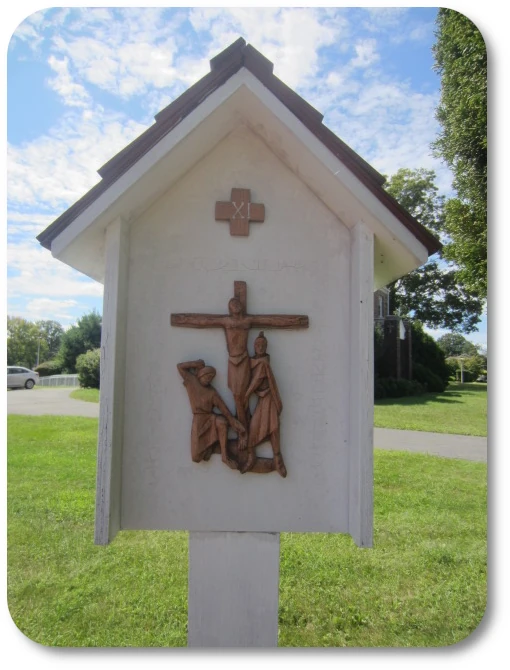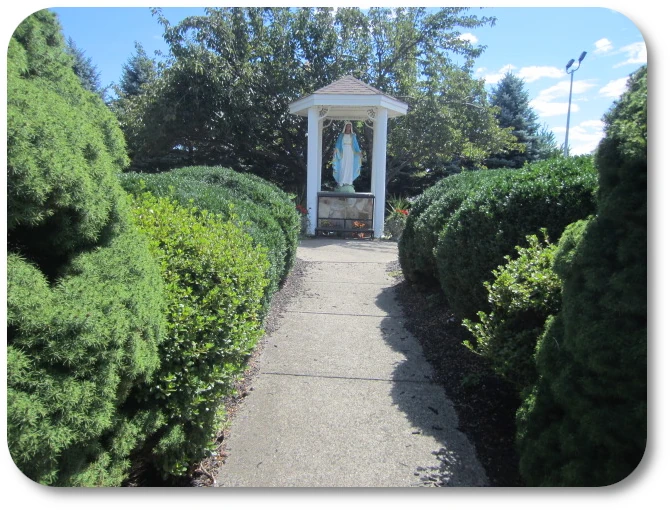Our Lady of Mount Virgin 11
The Our Lady of Mount Virgin 11 of the Cross, where Jesus is nailed to the cross, stands as one of the most heart-wrenching and poignant moments of His Passion. This station highlights the intense physical agony and profound spiritual significance of Jesus' sacrifice for humanity. As we reflect on this moment, we are invited to delve deeper into the themes of suffering, love, and redemption that are intricately woven into this event.
That's it in a nutshell, but I feel the agony of each of those nails being driven into my hand. Forget each I stand corrected I would pass out on the first nail. My Lord having to endure this excruciating pain for my sins. God loves me so much to do this so that I can have a relationship with Him. I have to let this sink in as I sit quietly here meditating on Our Lady of Mount Virgin 11.
Jesus is Nailed to the Cross

Our Lady of Mount Virgin 11
V. We adore Thee, O Christ,
and we praise Thee.
R. Because by Thy holy Cross,
thou hast redeemed the world.

Prayer
My Jesus loaded with contempt, nail my heart to Thy feet, that it may ever remain there, to love Thee and never to quit Thee again. I love Thee, and I repent of ever having offended Thee.
The Way of the Cross of Saint Alphonsus Liguori
Our Father...
Hail Mary...
Glory Be...
v. Have Mercy upon us O Lord.
r. Have Mercy on us.
May the souls of the faithful departed, through the mercy of God, rest in peace.

Ponder as Mary Pondered
Agony
Jesus I am sorry for my sins, I am sorry that all these years I didn't even recognize you. I searched and searched but for all the wrong reasons. That first nail is too much. Jesus the excruciating pain you must have felt at that first nail.
The method of crucifixion was designed to maximize suffering, making Jesus' endurance an act of immense fortitude and love. This aspect of the station invites us to contemplate the physical sacrifices made out of love and duty in our own lives.
The Nails
The nails used in Roman crucifixions were typically large, iron spikes, ranging from 5 to 7 inches in length and about 0.5 inches in diameter. Made of iron, these nails were designed to be sturdy and durable, capable of supporting the weight of a human body. The size and strength of these nails ensured that the condemned would remain securely fastened to the cross throughout the crucifixion process.
The nails were driven through Jesus' wrists and feet, rather than the palms and arches as often depicted in art. Anatomically, nails through the wrists would support the weight of the body without tearing through the flesh, as the bones in the wrist would provide a secure anchor. Similarly, the nails in the feet were likely driven through the space between the bones, ensuring maximum stability.
Symbol of the Cross
For many individuals, the cross holds personal significance that goes beyond its historical and religious contexts. It can be a source of comfort and strength, a reminder of personal sacrifices, or a symbol of hope in difficult times. The cross invites reflection on themes of suffering, redemption, love, and hope, making it a deeply personal and multifaceted symbol.
Sometimes our cross can be as simple as the bag we are carrying. Is it heavy, is it an annoyance to us, is the weather too hot to carry this bag and so on. Each of us carry some kind of cross through our lifetime. But I believe Jesus says, "come to me my burden is light."
Here is an explanation of the cross. In summary, the cross is a complex and multifaceted symbol with profound meanings in religious, cultural, historical, and personal contexts. It stands as a testament to the human experience of suffering and the hope of redemption, making it one of the most powerful symbols in the world.
The Cross in Modern Context
In contemporary times, the cross continues to be a potent symbol. It is often worn as a piece of jewelry, not only as a declaration of faith but also as a fashion statement. In this context, it can sometimes lose its religious significance and become a cultural icon. The cross is also used in memorials and monuments, such as war memorials, symbolizing sacrifice, courage, and remembrance.
Historical and Cultural Symbol
Beyond its religious significance, the cross has also been used as a powerful cultural and historical symbol. In ancient cultures, the cross was a pagan symbol representing various concepts, such as the four cardinal directions or the joining of heaven and earth. The Celtic cross, with its distinctive circle, combines Christian and pre-Christian symbolism, representing both eternity and the natural world.
The Christian Symbol
For Christians, the cross is the central symbol of their faith. It represents the crucifixion of Jesus Christ and His victory over death and sin. The cross signifies the profound love of God, who sent His only Son to die for humanity's redemption. This act of sacrifice is seen as the ultimate act of love and mercy. The empty cross also represents the resurrection of Jesus, symbolizing hope and eternal life.